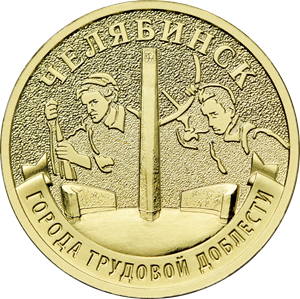Chelyabinsk
Obverse
the denomination of the coin ‘10 РУБЛЕЙ’ (10 RUBLES), inside the figure ‘0’ hidden pictures of the number ‘10’ and the inscription ‘РУБ’ (RUB), visible alternately when changing the angle of vision, stylised images of laurel and oak branches on the left and on the right, respectively, the inscription ‘БАНК РОССИИ’ (BANK OF RUSSIA) along the top rim, the year of issue ‘2025’ along the bottom rim, the mint mark at the bottom right.
Reverse
a relief image of the stele City of Labour Valour supplemented with the images depicted on its lower part and the inscriptions around the circumference: ‘ЧЕЛЯБИНСК’ (CHELYABINSK) at the top and ‘ГОРОДА ТРУДОВОЙ ДОБЛЕСТИ’ (CITIES OF LABOUR VALOUR) at the bottom along the ribbon.
Authors
Designer: A.A. Brynza.
Sculptor: A.N. Bessonov.
Mint: Moscow Mint (ММД).
Edge: 6 sections with 5 corrugations and 6 sections with 7 corrugations alternated with 12 smooth sections.
Discover more
Chelyabinsk was awarded the honorary title City of Labour Valour for the great contribution of its residents to the Victory in the Great Patriotic War of 1941–1945, uninterrupted manufacture of military and civilian products at industrial enterprises and people’s labour heroism and commitment.
The city’s considerable industrial capacities, advantageous location, and rich natural resources made Chelyabinsk an important defence centre of the country. All that played a special role during the Great Patriotic War. From the very beginning of the war, factories and machinery were evacuated to Chelyabinsk from invaded territories.
During the war, the city enterprises produced diesel engines, ammunition (cartridges, mines, bombs, land mines, and artillery rockets), electric equipment for combat vehicles, components for tanks and ZIS vehicles, armoured glass for aircraft, and other military-purpose products. By the end of the war, every third tank and combat aircraft was made from Chelyabinsk steel.
It was at the start of the war that Chelyabinsk acquired a second unofficial name – Tankograd (literally, the City of Tanks). The Chelyabinsk Tractor Plant joined with two evacuated plants (the Kirov Plant from Leningrad and the Kharkov Engine Plant) to start producing tanks. It was the only producer of heavy tanks and self-propelled vehicles in the country and was the main enterprise making diesel engines for tanks. During the war, it manufactured 18,000 combat vehicles, or a fifth of the total national output. The plant’s last wartime development was the IS-3 tank, also unofficially known as the Victory Tank, which became the best heavy tank of World War II. Importantly, it took only 33 days to launch the mass production of T-34 tanks. The plant’s staff was honoured with the Challenge Red Banner of the State Defence Committee 33 times; the plant itself received the Order of Kutuzov 1st class.
Sources: http://uralfo.gov.ru, https://mincult.gov74.ru, https://histrf.ru, Executive Order of the President of the Russian Federation No. 444, dated 2 July 2020, ‘On Awarding the Honorary Title of the Russian Federation City of Labour Valour’.


